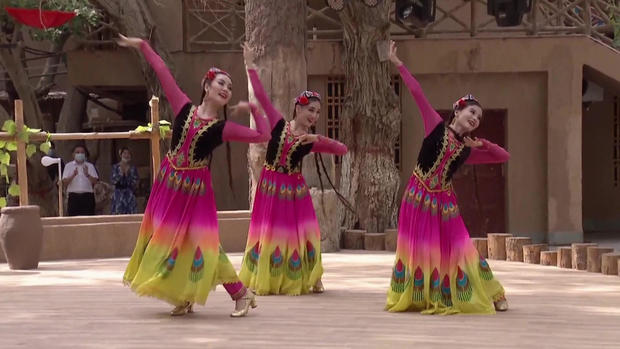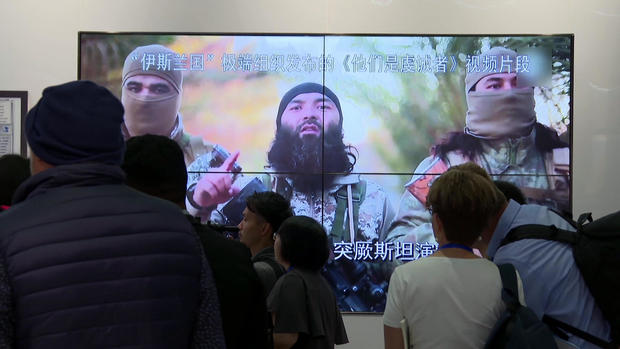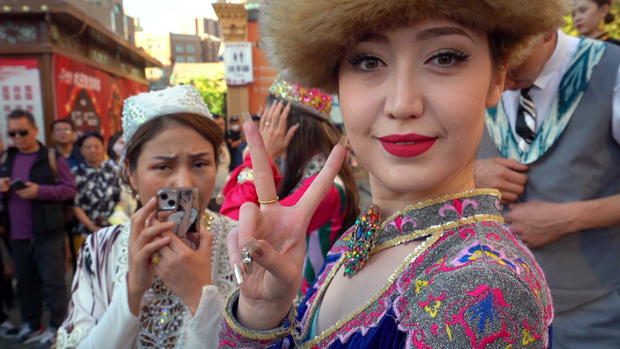
The rebranding of Xinjiang
Xinjiang Province, on China’s Western frontier – origin of the Silk Road, the ancient gateway for trade to the Middle East – was off-limits during the pandemic. But it is open again, and these days it’s being marketed by the state both for its beauty and its business opportunities.
CBS News was a part of a tour planned by the Chinese Information Office. The office arranged for buses, organized the schedule, and supplied translators and staff to assist us throughout the trip. We were able to see a variety of things, including farming equipment, historical landmarks, and even witnessed the online sale of plums on TikTok.
CBS News
We did not witness any proof of the detention facilities and jails that caused Xinjiang to become a global controversy.
According to the Uyghur Human Rights Project based in Washington, the Chinese Communist Party views the Uyghur population as a threat due to their distinct identity from the majority Han Chinese and sees them as a potential obstacle to their dominance over China.
The government has dedicated significant resources to developing Xinjiang, including a high-speed train project worth billions of dollars. We saw numerous signs of China’s massive investments in infrastructure, such as wind farms and tourist facilities. The implication is that human rights violations should be overlooked in favor of enjoying the attractions.
Zou Bin, one of our translators, is Han Chinese. He grew up in Xinjiang and wanted to tell us how proud he is of the area he’s always called home. “I hope you could change some of the ideas or impressions which has been spread by some Western media about Xinjiang,” he said.
“Are you suggesting that we leave with a new narrative?” we inquired.
“Yes, based on what you are observing.”
Initially, the Chinese government refuted the existence of Uyghur detention centers. However, when satellite images revealed their presence, the government claimed that they had all been closed in 2019. An official, who preferred not to be on camera, acknowledged that we had passed by one of these centers, but dismissed it as inconsequential since it was no longer operational.
Instead, we witnessed traditional dancing, the making of local wine, and a village that had been renovated and enhanced specifically for visitors.
However, we only caught fleeting glimpses of private Uyghur life.
The Extremist Museum in the capital city of Xinjiang, Urumqi, is the only acknowledgement of China’s actions against the Uyghur population. The museum’s displays depict violent attacks carried out by Uyghur extremists since the 1990s, including one where 1,700 people were injured and 200 stores were set on fire. The underlying message is that the Chinese government felt compelled to take strong measures in response.
CBS News
When it was suggested that the Chinese government’s actions against the Uyghurs were a reaction to terrorist attacks, Babur Ilchi of the Uyghur Human Rights Project responded, “In my opinion, if your reaction to acts of violence or suspected terrorism is to imprison an entire ethnic group in massive concentration camps, then you have exceeded your ability to protect yourself.”
During the evening in Urumqi, there was a noticeable amount of security. However, due to the widespread use of facial recognition cameras, the overall policing and atmosphere seemed calm.
The fact that journalists were allowed to tour in China suggests that the government believes they have successfully controlled the Uyghur population. The events and information presented during this tour highlight China’s efforts to change the image of Xinjiang from a place known for severe human rights abuses against the Uyghurs to a popular tourist destination.
In the past, the customs of Islam were prevalent throughout Xinjiang. Religion played a significant role in the daily life of the Uyghur community, along with conservative practices such as veils for women and beards for men. However, this is no longer the case. The traditional ways of the Uyghur people have been restricted. The current law discourages open displays of religion, including attire, in public settings.
The Uighurs of China 19 photos
The promotion of Han Chinese dominance is currently supported by official policies. The former capital of Kashgar has been renamed “Kashi” to reflect its Chinese Mandarin name.
In the markets of Xinjiang, the Uyghur culture has been commercialized and tailored to fit a more Disney-like image. The once sacred Id Kah Mosque now offers admission tickets to visitors.
CBS News
At the marketplace in Urumqi, we encountered Uyghur Imamu Meimeti Sidike. He shared that he had spent seven months in a re-education camp due to his strong religious beliefs. He admitted to restricting his wife from working and now, he has changed his views and follows the party’s stance. He claims to have recognized that he was violating Chinese laws and has since reformed.
We may never know the true extent of his freedom to speak, as he was constantly monitored by surveillance cameras and accompanied by official guides.
In Nazerbag village kindergarten, it’s time for the local Uyghur children to shine. While the Chinese government claims to support bilingual education for them, the language used in the classroom and books is Mandarin.
The Chinese government is attempting to convince the world that their strict measures were necessary for stability, security, and the well-being of the Uyghur people. However, if the Uyghurs have a different viewpoint, they are not expressing it, especially to us. According to China, their goal has been achieved.
Welcome to Xinjiang 2.0.
CBS News
This story was created by Randy Schmidt.
More
Source: cbsnews.com



